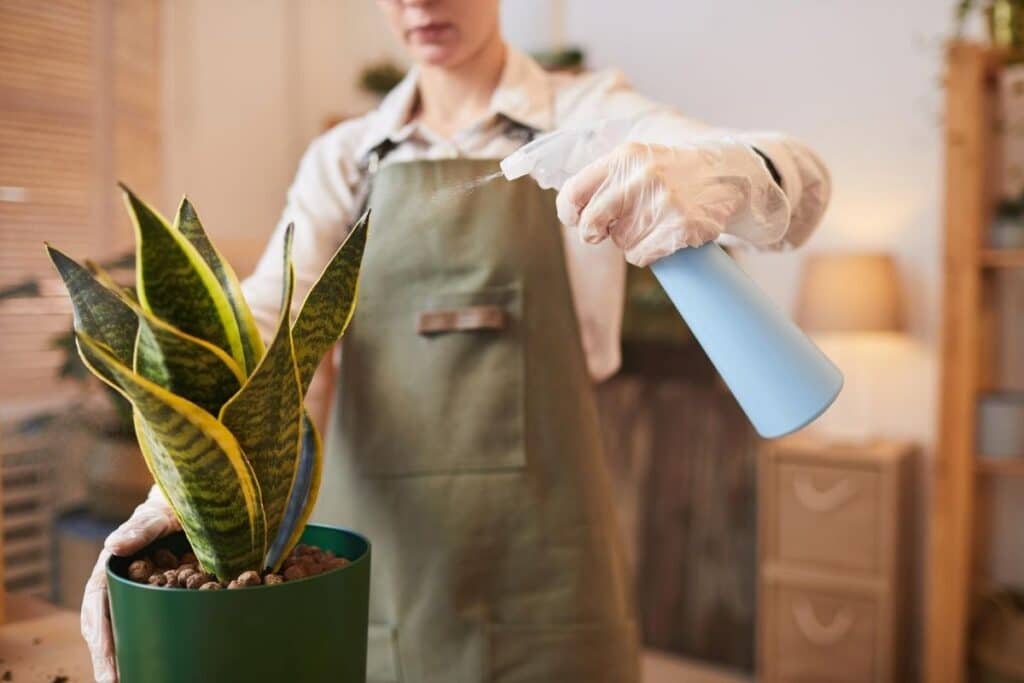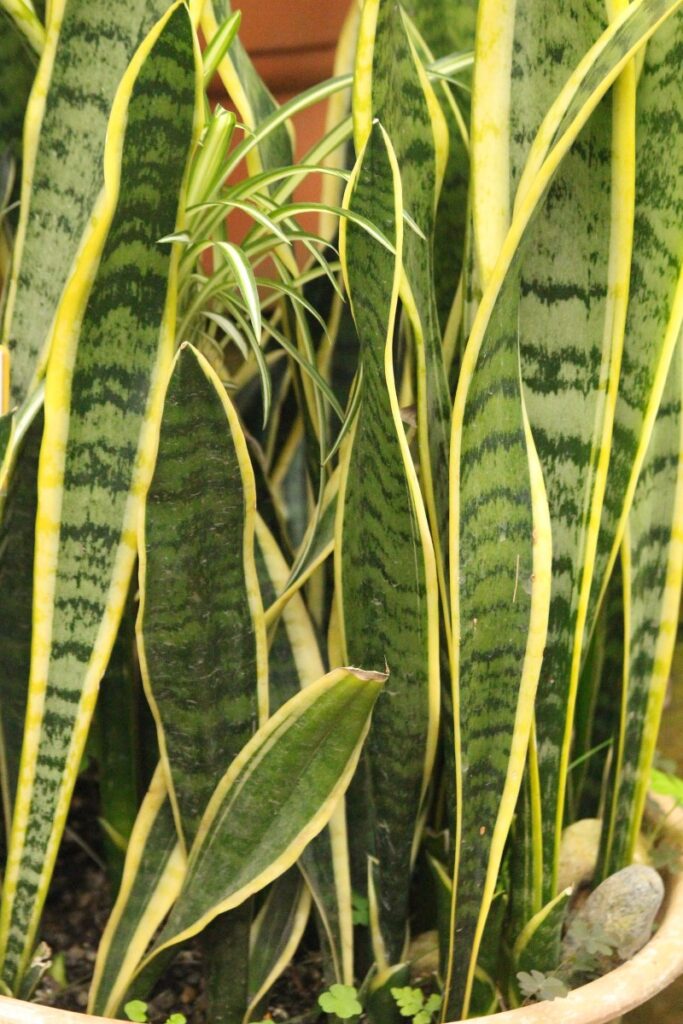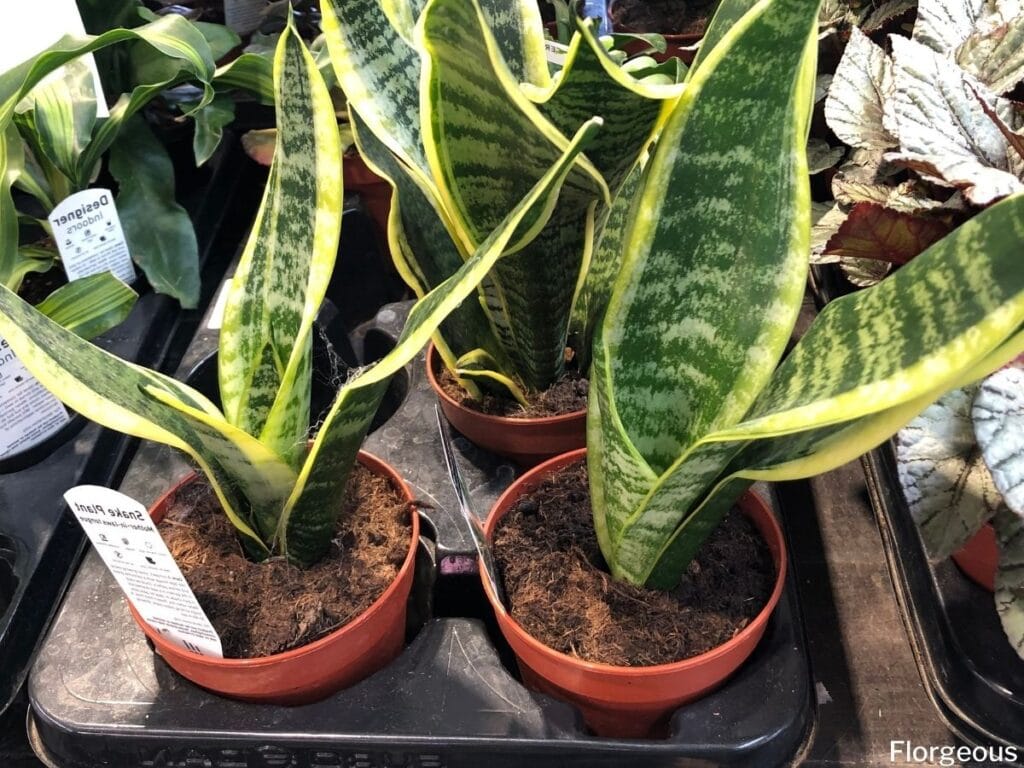Snake plants may not be new in the houseplant scene but what makes them shine is their ability to bring lasting beauty indoors. Their vertical growth and sculptural foliage create a bold but inviting statement in any space and many growers find it easy to keep them since they do not ask a lot.
Sansevieria is a genus of about 60 plants belonging to the Agave family. S. trifasciata, the most common of the genus, is a successful indoor plant. The plant is a known air purifier, eliminating nitrogen oxides and formaldehyde from the indoor atmosphere. It is characterized by the sword-like thick leaves, often with scale-like patterns of yellow and green or green and silver, gathered as a clump at the base of the plant just like most agaves.
Because of the variegation of the long leaves, the plant is commonly referred to as snake plant. It also goes by the names “mother-in-law’s tongue” and viper’s bowstring hemp. Other names include Dracaena trifasciata, Sansevieria trifasciata, Saint George’s sword, good luck plant, bowstring hemp, African bowstring hemp, and snake plant.
A native of Brazil and Africa, the snake plant is considered a succulent and prefers open and bright, warm areas. In their native habitat, snake plants are found in arid, semi-arid, and dry deciduous forests, often growing in rocky soils or in the cracks of rocks and boulders.
Each leaf can reach a height of 50 cm (20 in) and although rare for those grown indoors, snake plants produce long flower stalks covered in fragrant small creamy white buds and lily-like flowers.
Plant Facts
| Scientific name | Sansevieria & Dracaena spp. |
| Common names | Snake plant, Mother-in-law’s-tongue, Saint George’s sword, good luck plant, bowstring hemp, African bowstring hemp |
| Family | Asparagaceae |
| Plant Type | Houseplant, succulent |
| Height and Width | 0.5-8 ft. tall (indoors), 0.5–3 ft. wide (indoors) |
| Origin | Africa, including Madagascar, Asia |
| Flower colors | Pink, red, dark green, brown |
| Foliage color | Various shades of green, yellow and white |
| Sun Exposure | Medium-bright indirect light |
| Soil Type & pH | Well-drained, slightly acidic to neutral soil |
| Special features | Air purifier, low maintenance |
How to Grow Snake Plants
Growing snake plants indoors, especially with the new and exciting varieties today is always a smart choice. Most popularly known as an indoor foliage plant, the snake plant is grown in planters and pots and the smaller varieties are used in dish gardens and terrariums. In coastal areas and subtropical locations, sansevierias are mass planted for outdoor installation too.
Just as the common name “viper’s bowstring hemp” suggests, this plant is a source of fiber that is used in making bowstrings. The leaves also have antiseptic properties and they were traditionally used as bandages to dress wounds.
Despite their industrial and medicinal uses throughout history, snake plants are reported to have mildly toxic substances too like hemolytic saponin which can cause excessive salivation when ingested, and allergic dermatitis when plant juices come in contact with specific types of skin.

Propagation
Snake plants can be propagated by seeds but it takes time. Growers produce new plants by cutting and division which are the most common ways to propagate snake plants. Several cuttings can be obtained from one leaf and then inserted into the growing medium.
Plants that have overgrown their containers can be divided, keeping the roots intact, and planted into individual pots. It takes about 3 to 5 weeks for the plants to establish roots and grow new leaves.
Soil
Snake plants require a well-drained soil that is neutral to slightly acidic. A succulent or cactus mix is a great growing medium for these plants.
These are available ready to use, but you can also mix up your own soil if you enjoy getting your hands dirty. An ideal snake plant soil mix would contain potting soil that contains organic nutrients, coarse sand or perlite to improve drainage, and peat moss to lower the pH slightly.
Pruning
There are many reasons that might make you want to prune your snake plant. You may wish to improve its shape, remove unhealthy growth, or just make the plant a little smaller. You will need a sharp and robust cutting tool for the job, and be sure to sterilize it first to avoid introducing any pathogens.
It is best to prune these plants when they are actively growing and in good health to limit stress on the plant. Dark green leaves that have been cut will develop dry brown edges, so pruning them low near the rhizome might bring the most attractive results.
Remember, these plants can be divided at the rhizome, so a plant that has grown too large, can be turned into two plants instead of just removing leaves. Snake plants can also be propagated from leaf cuttings, so there is always the opportunity for growing your collection of these wonderful houseplants.
Repotting and Transplanting
These plants don’t mind getting a little root bound so resist the urge to repot right away. Instead, look to place the plant into a more decorative container in its nursery pot if you wish. Drill a drainage hole into the bottom of the nursery pot if it does not already have good drainage.
Once the plant is well established, consider repotting snake plants into an unglazed pot that encourages better airflow and drainage. It is important to go up in pot size incrementally, to maintain similar moisture conditions around the roots of the plant. This gradual transition gives the plant room to grow comfortably.
Over time, the pot will become congested with emerging rhizomes and new plants so repotting is ideal every 2 to 3 years.

How to Care for Snake Plants
The plant has an indoor lifespan of up to 10 years, depending on maintenance. Since the leaves are the crowning glory of this plant, they should be maintained by wiping off accumulated dust and dirt. Neem oil spray also provides a natural gloss to the leaves as well as protection from pests.
Here are some basic snake plant care tips you must know:
Water
Outdoors and in fields, sansevierias require ample amounts of water and less when grown under structures, but they are known to be drought-tolerant too. With a well-draining soil, they should be thoroughly watered once a week. Avoid letting the plant sit in water, as overwatering causes the leaves to droop while too little water dries out the leaves and makes them look wrinkled.
See more: How to water a snake plant
Sunlight
Snake plants are highly versatile and can practically grow anywhere from full sunlight to poorly-lit areas. But ideally, they should be grown under moderate to bright indirect light.
Like many plants with leaf variegation, the color intensifies when they receive enough exposure to direct sunlight. However, those grown in heavily shaded spaces have slow growth and elongated, weaker leaves.

Temperature and Humidity
Since they originated from areas with humid and warm climates, 70-90 °F is the optimum temperature for the snake plants to grow best. Temperatures should not be allowed to go below 45°F or the plant will turn mushy and die.
Fertilizer
Snake plants are relatively slow growers. They are not heavy feeders, being well adapted to life in poor soils. They will respond to an application of fertilizer, however.
Fertilizer application once every 3 months will help keep the leaves vibrant and promote new growth. It is not necessary to fertilize these plants during the winter and fall in areas where there is a marked difference in seasonal conditions.
Pest and Diseases
Insects like caterpillars and thrips are common in snake plants. Caterpillars feed on the leaves leaving holes in the center or edges of the leaves. Leaves infested by thrips become curled and distorted. Although not very serious during the early stages, these pests should be eradicated by an application of mild systemic insecticides.
When choosing snake plant companion plants, make sure your companions won’t carry any diseases or insects that will affect your Sansevieria plants.
Sansevierias are also vulnerable to leaf spot, blight, and leaf and root rot. These can be prevented by the application of recommended pesticides but safety measures like sanitation of gardening tools should also be practiced to prevent the spread of diseases. Keeping the foliage dry does not only prevent water and dust marks on the leaves but also helps to avoid the development of bacterial and fungal infections.
See more: Why is my snake plant turning yellow?
Common Varieties and Cultivars
Here are some common types of snake plants for beginners:
- Dracaena trifasciata
- S. trifasciata ‘MoonShine’
- S. trifasciata ‘Laurentii’
- S. trifasciata ‘Golden Hahnii’
- S. trifasciata ‘Black Robusta’
- S. kirkii ‘Coppertone’
- S. rorida
- S. patens
- S. cylindrica (cylindrical snake plant)
- S. zeylanica
- S. trifasciata ‘Hahnii Streaker’
- S. trifasciata ‘Twisted Sister’
- S. trifasciata ‘Black Gold’
- S. trifasciata ‘Whitney’
- S. pinguicula
- S. sordida
FAQs
How do you take care of a snake plant indoors?
To care for a snake plant indoors, provide it with bright, indirect light, although it can tolerate low light conditions. Allow the soil to dry out between waterings, as snake plants are susceptible to root rot in soggy soil. Avoid overwatering and ensure the pot has proper drainage.
What are the disadvantages of snake plant?
While snake plants are generally low-maintenance and beneficial for indoor air quality, they do have some disadvantages. Overwatering can lead to root rot, and they can be sensitive to cold temperatures. Additionally, some people may be allergic to the sap of snake plants.
Can a snake plant go 3 weeks without water?
Snake plants are quite resilient and can tolerate periods of drought. However, it’s not ideal to leave them without water for three weeks, as prolonged drought can stress the plant and affect its health. It’s best to water the plant when the top inch of soil feels dry.
How do I know if my snake plant is overwatered?
Signs that your snake plant may be overwatered include yellowing or softening of the leaves, mushy or blackened roots, and foul-smelling soil. If you notice these symptoms, allow the soil to dry out completely before watering again, and consider repotting the plant in fresh, well-draining soil if root rot is present.
Conclusion
Snake plants are ideal houseplants. They thrive with very little attention and provide long-lasting evergreen foliage that breathes life into your home. These plants aren’t only good-looking, however, they filter the air we breathe, actively improving our living conditions. If you’re considering growing your own snake plant, the tips in this article can be used with confidence. Happy growing!
For more plants to grow, see our list of plants for indoor.
See more: Snake plant benefits
References
Reference List
(1) Henley, R. et. al. “Sansevieria Production Guide”. 1991. University of Florida, IFAS. Retrieved from https://mrec.ifas.ufl.edu/Foliage/folnotes/sansevie.htm.
(2) Squire, D. “Houseplant Handbook”. 2017. I5 Publishing LLC. P. 273.
(3) Osterhoudt, M. “Keeping it Real-Health Benefits of Indoor Plants, Which to Get and How to Take Care for Them”. 2013. Lulu Press Inc. P. 8.
(4) Spoerke, S. “Toxicity of Houseplants”. 1990. CRC Press. P. 256.
(5) Odenwald, N. & Turner, J. “Identification, Selection, and Use of Southern Plants: For Landscape Design”. 2006. Claitor’s Law Books and Publishing. P. 720.
Close
*Image by SeventyFour/depositphotos







